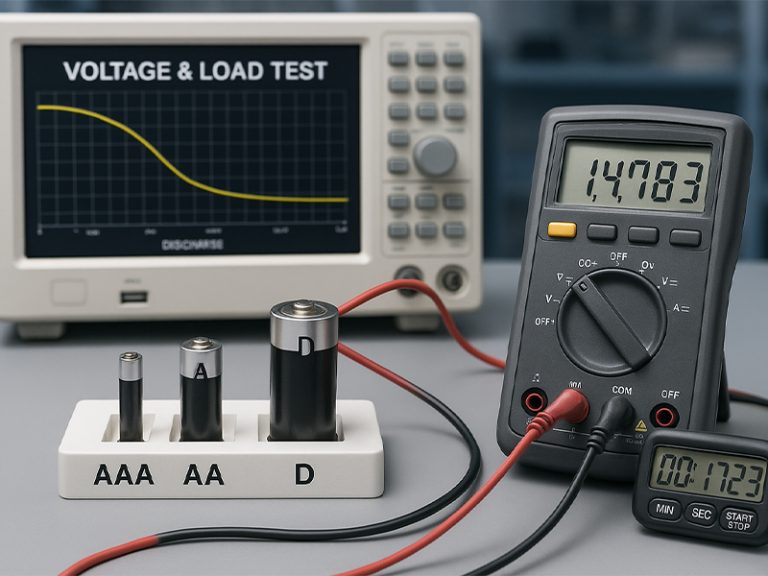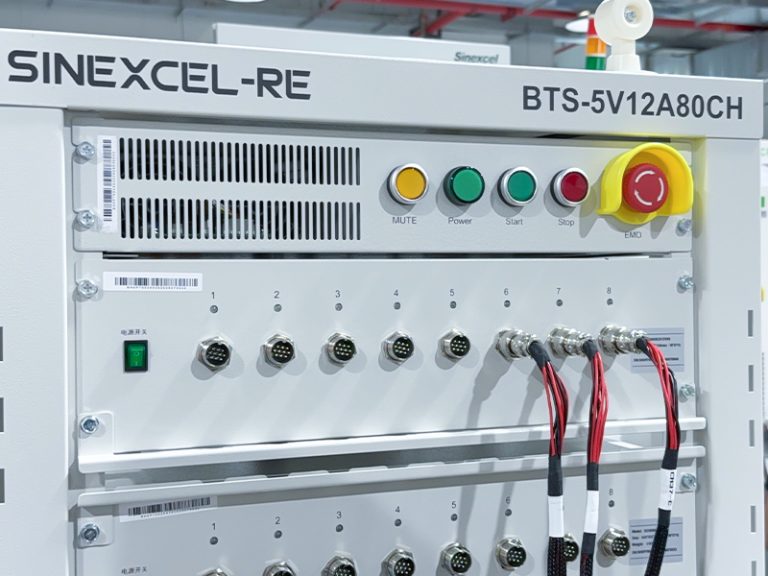This article is part of Sinexcel-re EV battery testing insights, explaining voltage systems and the role of advanced battery test systems in modern electric vehicles.
Typically, 12V battery system used to be employed in cars. This voltage can vary a little from its standard value and fall anywhere between 12.6 to 14.4V. Anyhow, present-day electric and hybrid electric vehicles (EVs and HEVs) or cars consist of two battery systems and thus two voltage systems. One is 12V system like conventional cars. Other battery system is comprised of multiple battery modules where each module is made by assembling several battery cells. This voltage category is relevant to Hybrid Electric Vehicles (HEVs), Full Hybrid Electric Vehicles (FHEVs), and Plug-in Hybrid Electric Vehicles (PHEVs). Voltage in batteries for these vehicles can go up to 400 and 800V. These batteries are termed as high voltage car batteries. These battery systems in cars bring higher efficiency, quicker charging, and improved performance. Currently, these batteries pose some potential issues like higher prices and safety issues. This article discusses various aspects of high voltage car batteries including their selection, testing, benefits, safety concerns, important disadvantages, and progress to address these disadvantages.
What You Need to Know About a Typical Car Battery or a 12V Battery?
Typically, car batteries used to be 12V batteries. When these batteries are fully charged, their voltage goes up to the tune of 14.4 volts. Anyhow, as battery’s energy is depleted, voltage drops to stay around its nominal voltage of 12V. When charging of a battery is around 50%, its open circuit voltage turns out to be 12.1V. These batteries need maintenance on regular basis especially because of evaporation of water during charging and use conditions.
These batteries provide power to start engine of vehicle and their voltage drops temporarily. Anyhow, after engine is started, battery voltage is restored to its nominal value because alternator starts charging battery.
When this 12V battery is used in modern day hybrid or other electric vehicles, their purpose is to perform start function (optional) and power small loads like lights, wipers, power steering, ECU (electronic control unit), radio, and windows.
What is Meant by High Voltage Car Batteries?
Traditionally, all cars or vehicles had 12V battery systems. With increased emphasize on reducing carbon emissions and addressing climate change, vehicles are designed which have batteries with voltage much higher than 12V. Such batteries are known as high voltage car batteries. High voltage car batteries have further categorization based on level of voltage which is related to extent of hybridization of vehicle and purpose of battery. Here, battery voltages for different types of vehicles are discussed.
Battery in Mild Hybrid Electric Vehicles (MHEVs):
In these vehicles, battery voltage stands around 48V nominal. These batteries perform some basic functions like start and stop, power assistance, and regenerative braking. These batteries are not large enough to drive the car on electric power. Anyhow, these can improve efficiency and reduce emissions effectively. An appropriate example of 48V battery car is Audi A6 55 TFSI e.
Battery in Full Hybrid Electric Vehicles (FHEVs):
Batteries in Full Hybrid Electric Vehicles (FHEVs) are capable of delivering enough power to run the vehicle on electric power for short distances and assist in fulfillment of power needs for longer distances. This stance on purpose makes it clear that batteries in Full Hybrid Electric Vehicles shall be somewhat larger and robust. Typically, voltage range for these batteries lies between 200 and 300V to save more fuel and furnish more electric power. Toyota Prius is an example of full hybrid vehicle as battery voltage for Toyota prius is 201.6V.
Battery in Plug-in Hybrid Electric Vehicles (PHEVs):
Plug-in hybrid electric vehicles have batteries larger than Full Hybrid Electric Vehicles (FHEVs) with voltage range lying between 300 and 400V. These vehicles have onboard charger and their power electronic circuitry is relatively advanced and complex to let it control charging and discharging processes efficiently. Batteries in these vehicles can make the vehicle cover significant distance on battery alone. These large batteries also deliver power during acceleration of vehicles, capture regenerative power during braking, and lower emissions by reducing fuel consumption. Chevrolet Volt and BMW 330e are good examples of PHEVs.
800V Battery Architecture:
400V battery architecture has been norm for plug-in hybrid electric vehicles for quite some time. Anyhow, some car manufacturers have started producing cars which have 800V battery system instead of 400V system. It must be noted that voltage range for 800V cars lies between 600 and 900V. These battery systems have some key advantages over 400V like range is further extended, and charging speed is enhanced. Moreover, these batteries ensure better acceleration curves and higher absorption of regenerative energy. These advantages come with drawback of high price.
800V battery architecture brings some technical advantages also. For example, reduced weight and size of power system. In fact, as voltage goes higher, lesser current is needed to deliver same amount of power. To accommodate this lesser current, thin conduction wires also serve the purpose. Less current also means less heating, lower energy wastage, and quite less need for cooling. These factors help reduce vehicle’s weight substantially.
Some notable examples of 800V EV cars are Porsche’s Taycan, Kia’s EV6 and EV9, Tesla’s Cyber Truck, Zeekr’s 001, and XPeng’s G9.
Selecting High Voltage Car Batteries:
If you have an EV and you have to replace its battery, then you don’t have much options. Power system of each car is designed at the time of manufacturing to support a specific voltage or a specific voltage range at best. Already installed power system confines you to select battery which has nominal voltage falling between mentioned ranges. Anyhow, if you are considerate about battery voltage before buying the car, you must consider some capability factors like performance, charging time, pricing, available supporting infrastructure, range, and weight. It must be mentioned that inherently, all batteries are same. Number of battery modules and cells are the only variation making all these battery systems distinct from each other.
Some of the important factors are discussed here in detail. To make concepts clear, 400V and 800V battery systems are considered as examples because these two are most established and promising types as of now. Here, detailed comparison is established consistently between these two options.
Charging Time: As battery’s nominal voltage and its size increases, associated charging station and its current output also changes. In a 400V charging station, output current can’t be increased beyond limit to minimize losses, decrease heat generation, and ensure safety. In 800V battery system, charging station will be supplying current at 800V or somewhere in the voltage range of 600 to 900V. So low current will be required to charge this battery rapidly. Thus, 800V battery systems will support faster charging than those of 400V battery systems.
Performance: Voltage of battery will impact performance characteristics of vehicle also. During acceleration, cars demand higher amount of energy. With a 400V battery system, more current will be needed to give required acceleration. Capacity of wires, safety concerns, and losses will push system to keep current lower in safety range which might compromise performance e.g. acceleration curve. On the other hand, for an 800V battery system, it would be easy to follow demanded speed trajectory because of higher voltage and lower current.
Let’s discuss another performance parameter – regenerative braking – for EVs of both 400 and 800V system to clear the stance. 800V batteries can absorb higher amount of energy more quickly than those of 400V batteries. So 800V batteries will turn out to be more efficient than their counterparts.
Coming to range, 800V battery systems will make an EV more efficient and guarantee extended range.
Weight: As discussed earlier, to deliver same amount of power for any purpose, 800V battery system will need to deliver less amount of work. So, power system can be designed with thinner cables and lighter components. This is also because of lower heat losses due to lower current. So 800V battery system will lead to weight reduction in electric cars.
Charging Infrastructure: Currently, charging infrastructure for 400V systems is developed quite much. Because almost all car manufacturers were designing and manufacturing cars with 400V nominal voltage system and it became like a standard. Anyhow, charging infrastructure for 800V power systems is not developed yet and this aspect needs special consideration so benefits of these high voltage systems could be reaped. It must also be noted that 400V charging station can be used for 800V car battery systems but special electronic circuitry will be required in the vehicle to support low voltage charger.
Price: economies of scale impact every product and so production of batteries is also impacted by this. Batteries with lower voltage levels have been in the market for so long. Their mass production, advanced research, and increased utilization have brought their prices down. On the other hand, batteries with voltages as high as 800V don’t have very large market size and their use is not established as norm in EVs either. Moreover, research and development is lacking in design and production of these batteries. So, as of now, 800V batteries cost far more than other batteries.
Once all these aspects are discussed and a comparison is established between different types of batteries (based on voltage level), you are in the position to select a suitable battery or an electric car with suitable voltage level. You must consider safety, charging infrastructure around you, budget, your usage, and time dedicated for charging at minimum.
Testing High Voltage Car Batteries:
Battery system or battery module lies at the heart of an electric car. So rigorous testing and analysis is essential for safety, good performance, and prolonged life of battery and vehicle. For high voltage car battery testing, emulation of real-time operational scenario is the key where electrical, climatic, and load conditions are varied and tests are conducted.
Function Test Checks:
Function tests comprise a series of tests. Here, few important ones are mentioned.
Presence and correct working of communication interface is crucial to functioning of EVs. So, in function test checks, it is ensured that communication interface in working correctly. During this test, battery is attached with high voltage and Battery Management System is employed to check battery’s status. Defined charging pulses are given to charge the battery, discharge the battery, and checking SoC (State of Charge) continuously. Function tests are also executed to check if supported protocols are in place.
Safety Test Checks:
Safety checks are very important for High voltage batteries because of their operating voltage and varying operational conditions in vehicles. In safety checks, various tests are performed. For example, it is monitored if battery switches off or not upon receiving crash signal. Our high voltage battery test systems simulate real-world safety events to validate insulation, relay performance, and emergency shutdown responses.It includes monitoring of safe and immediate closing of output relays so power supply is cut-off to vehicle system. During safety checks, it is checked if BMS is fully functional and control unit is capable of reading all cells individually so health of each cell could be estimated. Insulation is also tested during safety tests.
Conclusion:
High voltage batteries are most costly and important component of electric vehicles. Extensive research has made it possible to design and manufacture high voltage batteries in economic friendly manner while ensuring that their performance suits requirements of electric vehicles. In this article, we discussed traditional vehicle batteries as well as high voltage car batteries. Currently, 400V system is most established one like a standard and 800V system seems to be most promising. Focus and research in this regard is needed to make 800V battery technology more economic and safe. Choosing appropriate battery based vehicle system while considering various aspects is also of paramount importance. Furthermore, performance and safety testing of high voltage car batteries is necessary for accurate functioning of vehicles and safety of passengers and car.Explore Sinexcel’s EV battery testing solutions for comprehensive high-voltage battery validation.



